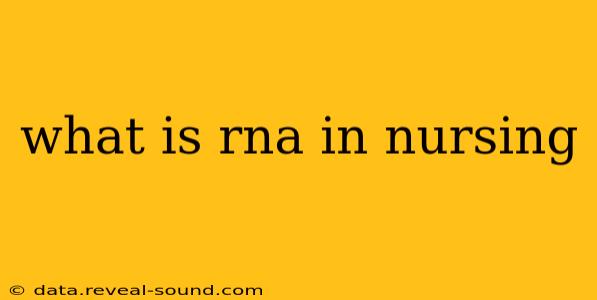Ribonucleic acid, or RNA, might not be the first thing that comes to mind when thinking about nursing. However, understanding RNA's role is increasingly crucial for nurses, particularly as advancements in molecular biology and genetics shape modern healthcare. While nurses aren't typically directly involved in RNA manipulation in labs, a foundational understanding of RNA’s function is vital for comprehending many aspects of patient care.
This article explores RNA's significance in nursing, addressing common questions and highlighting its relevance to various healthcare scenarios.
What is RNA and What Does it Do?
RNA is a nucleic acid, similar to DNA, but with key differences. While DNA acts as the blueprint for genetic information, RNA plays a crucial role in translating that blueprint into functional proteins. Think of DNA as the master plan stored safely in the nucleus, and RNA as the working copy that leaves the nucleus to direct protein synthesis in the cytoplasm.
There are several types of RNA, each with a specific function:
- Messenger RNA (mRNA): Carries the genetic code from DNA to the ribosomes, the protein synthesis machinery of the cell.
- Transfer RNA (tRNA): Transports amino acids (the building blocks of proteins) to the ribosomes, matching them to the codons on mRNA.
- Ribosomal RNA (rRNA): A structural component of ribosomes, crucial for the assembly and function of these protein-making factories.
Understanding these basic functions lays the groundwork for appreciating RNA's relevance in nursing.
How is RNA Relevant to Nursing Practice?
RNA's significance in nursing is primarily indirect, influencing various areas of patient care through its implications for disease processes and treatment strategies. Here are some key connections:
-
Genetic Disorders: Many genetic disorders are caused by mutations in DNA, which directly affect the RNA transcribed from those genes and consequently the proteins produced. Nurses caring for patients with conditions like cystic fibrosis, Huntington's disease, or various types of cancer must understand the genetic basis of these illnesses and how they manifest clinically.
-
Infectious Diseases: Viruses like HIV and influenza are RNA viruses, meaning their genetic material is RNA. Nurses caring for patients with these infections need to understand the viral life cycle and how antiviral drugs might target viral RNA replication or translation.
-
Pharmacogenomics: The field of pharmacogenomics studies how individual genetic variations (including variations in RNA processing) affect drug response. Nurses should be aware that a patient's genetic makeup might influence their response to medication, impacting dosage adjustments and potential side effects.
-
Diagnostics: RNA analysis is increasingly used in diagnostic testing. For example, the detection of specific RNA sequences can indicate the presence of a particular virus or cancer. Nurses should understand the significance of these tests and how the results inform treatment decisions.
-
Emerging Therapies: RNA-based therapies are rapidly evolving, including mRNA vaccines (like those used for COVID-19) and RNA interference (RNAi) technologies aimed at silencing specific genes involved in disease. Nurses need to stay informed about these advancements and understand the implications for patient care.
What are Some Common RNA-Related Tests Used in Healthcare?
Several tests rely on RNA analysis to detect and diagnose illnesses. These often involve techniques like:
-
Polymerase Chain Reaction (PCR): PCR is used to amplify specific DNA or RNA sequences, allowing for their detection even in small quantities. This is crucial for diagnosing infectious diseases. Real-Time PCR (qPCR) allows for quantification of RNA.
-
Reverse Transcription PCR (RT-PCR): RT-PCR involves converting RNA into DNA before amplification, allowing for the detection and quantification of RNA transcripts. This is widely used in viral load testing.
-
Microarray Analysis: This technique measures the expression levels of thousands of genes simultaneously, providing a snapshot of RNA activity within a cell or tissue. This can be helpful in cancer diagnosis and prognosis.
-
Next-Generation Sequencing (NGS): NGS allows for high-throughput sequencing of RNA molecules, enabling the detailed study of gene expression and RNA modifications. This is a powerful tool in research and advanced diagnostics.
Nurses need not be experts in these techniques, but familiarity with their purpose and application within the context of patient care is essential.
How Can Nurses Stay Updated on Advances in RNA and Related Technologies?
The field of molecular biology is constantly evolving. To stay current, nurses can leverage various resources:
-
Professional journals: Publications like the American Journal of Nursing and others regularly publish articles on advances in medical technology and related scientific breakthroughs.
-
Continuing education courses: Many institutions offer continuing education opportunities focused on genetics, molecular biology, and related topics.
-
Online resources: Reputable online resources like the National Institutes of Health (NIH) website provide accessible information on RNA research and its implications for healthcare.
In summary, while nurses may not directly manipulate RNA in the lab, a solid understanding of its function and relevance in various disease processes and treatment strategies is crucial for providing safe and effective patient care. The rapidly advancing field of RNA-based therapies and diagnostics further emphasizes the importance of ongoing learning and staying abreast of these crucial developments.
